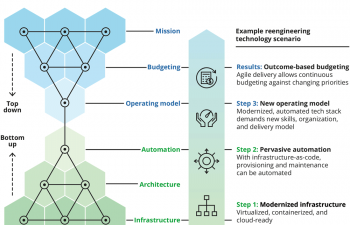Published on the 15/03/2018 | Written by Jonathan Cotton

Deloitte offers big thinking for beleaguered CIOs looking to influence but feeling the weight of a raft of new responsibilities…
At this point the term ‘disruption’ can feel like it’s something of a catch all explanation for everything absolutely anything happening in business: Exciting new market on the horizon? That’s disruption. Sweeping layoffs? Disruption. Anything with the word data in it? Definitely disruption.
But there’s a good a reason for the monomania. Markets don’t evolve anymore – they transform. Helping IT departments cope with that degree of change is part of Deloitte’s Tech Trends 2018 series. Reengineering technology: Building new IT delivery models from the top down and bottom up looks at how present day future shock is affecting CIOs and finds that IT department heads increasingly find themselves split between the heady opportunities offered by a fluid business landscape and the heavy responsibility guiding and inspiring teams to meet those challenges.
First things first: CIOs are highly cognizant of the position in which they find themselves – as is the rest of the C-Suite.
“In a 2016 – 17 Deloitte survey of executives on the topic of IT leadership transitions, 74 percent of respondents said that CIO transitions happen when there is general dissatisfaction among business stakeholders with the support CIOs provide,” says the report.
“Not surprisingly, 72 percent of those surveyed suggested that a CIO’s failure to adapt to a significant change in corporate strategy may also lead to [his/her!] transition out of the company”.
And there’s a rationale behind the slightly menacing tone. While the IT department has played a significant role in reshaping the way business done – and enterprise itself – it’s failed to apply such transformational thinking to the IT department itself.
That, says Deloitte, is precisely what’s all about to change: “Over the next 18 to 24 months, we will likely see CIOs begin reengineering not only their IT shops but, more broadly, their approaches to technology. The goal of these efforts will be to transform their technology ecosystems from collections of working parts into high-performance engines that deliver speed, impact, and value.”
This trend is what the research company is calling ‘Re-engineering technology’, a trend in which new models of IT delivery are created, old dogma questioned and, if all goes well, better outcomes achieved.
This, says Deloitte, requires a two headed approach: ‘Bottom up’ and ‘top down’.
Starting from the bottom, that means embracing automation, removing ‘technical debt’ and supporting infrastructure.
“There are automation opportunities throughout the IT life cycle,” says Deloitte.
“Almost all traditional IT operations can be candidates for automation, including anything that is workflow-driven, repetitive, or policy-based and requires reconciliation between systems. Approaches have different names: robotic process automation, cognitive automation, intelligent automation, and even cognitive agents. However, their underlying stories are similar: applying new technologies to automate tasks and help workers handle increasingly complex workloads.”
Think automated provisioning, testing, building and deployment, as well as applications and platforms that are self-monitoring, self-learning, and self-healing.
Technical debt – or put another way, ‘the cost of additional rework by choosing easy, short-term technical solutions instead of better (but less-convenient) approaches’ – can be as damaging as financial debt. Left unattended, organisations can find themselves spending more and more time coping with their growing technical debt – often characterised as ‘maintenance’ – missing valuable opportunities to grow and improve.
“Companies can also accrue technical debt in physical infrastructure and applications, and maintaining legacy systems carries certain costs over an extended period of time. Re-platforming apps (via bare metal or cloud) can help offset these costs and accelerate speed-to-market and speed-to-service.”
“Organisations that regularly repay technical debt by consolidating and revising software as needed will likely be better positioned to support investments in innovation,” says Deloitte.
Finally, the ‘bottom-up’ approach requires agile infrastructure – and that means going cloud-first.
“There is a flexible architecture model whose demonstrated efficiency and effectiveness in start-up IT environments suggest that its broader adoption in the marketplace may be inevitable,” says Deloitte. “In this cloud-first model – and in the leading practices emerging around it – platforms are virtualized, containerized, and treated like malleable, reusable resources, with workloads remaining independent from the operating environment.”
Deloitte says that architectural agility brings myriad strategic and operational benefits and those benefits only grow more profound in a competitive landscape constantly being reworked via tech disruption.
As CIOs are forced to reach further and further into new areas of the business, organisations need to be prepared to make ‘top-down’ changes too. Currently, CIOs find themselves juggling the management of IT departments day-to-day with the pressure to also create new products and services, develop new ways to nurture talent, and vet and prototype ideas around what the company may want to be in the future. Something has to give and that, Deloitte says, is the traditional CIO operating model.
This first step is to begin breaking down knowledge and skill silos within the business and reorganising IT workers into “multi-skill, results-oriented teams”.
“Ask yourself,” offers Deloitte, “are there opportunities to share resources and talent? For new capabilities, can you create greenfield teams that allow talent to rotate in or out as needed? Can some teams have budgets that are committed rather than flexible? The same goes for the silos within infrastructure: storage, networks, system administration, and security. What skill sets and processes can be shared across these teams?”
And as the silos disappear, so too do traditional budgeting constraints and as the line between ‘us’ and ‘them’ becomes a little less clear, be prepared to embrace ambiguity – at least as far as budgets are concerned.
“We are beginning to see a new budgeting model emerge in which project goals reorient toward achieving a desired outcome,” says Deloitte. “For example, if ‘customer experience’ becomes an area of focus, IT could allocate funds to e-commerce or mobile products or capabilities.”
“Increasingly, CIOs are becoming more deliberate about the way they structure and manage their project portfolios by deploying a 70/20/10 allocation: Seventy percent of projects focus on core systems, 20 percent focus on adjacencies (such as the “live factory” example above), and 10 percent focus on emerging or unproven technologies that may or may not deliver value in the short term.”
As the old lines blur, CIOs and the companies they work it need to adopt a new approach, one that recognises that IT is now responsible for a much bigger part of the business puzzle. Therein lies both the challenge and the opportunity.




























